- Home
- About
- Map
- Trips
- Bringing Boat West
- Migration West
- Solo Motorcycle Ride
- Final Family XC Trip
- Colorado Rockies
- Graduates' XC Trip
- Yosemite & Nevada
- Colorado & Utah
- Best of Utah
- Southern Loop
- Pacific Northwest
- Northern Loop
- Los Angeles to NYC
- East Coast Trips
- Martha's Vineyard
- 1 Week in Quebec
- Southeast Coast
- NH Backpacking
- Martha's Vineyard
- Canadian Maritimes
- Ocracoke Island
- Edisto Island
- First Landing '02
- Hunting Island '02
- Stowe in Winter
- Hunting Island '01
- Lake Placid
- Chesapeake
- Provincetown
- Hunting Island '00
- Acadia in Winter
- Boston Suburbs
- Niagara Falls
- First Landing '99
- Cape Hatteras
- West Coast Trips
- Burning Man
- Utah Off-Roading
- Maui
- Mojave 4WD Course
- Colorado River Rafting
- Bishop & Death Valley
- Kauai
- Yosemite Fall
- Utah Off-Road
- Lost Coast
- Yosemite Valley
- Arizona and New Mexico
- Pescadero & Capitola
- Bishop & Death Valley
- San Diego, Anza Borrego, Joshua Tree
- Carmel
- Death Valley in Fall
- Yosemite in the Fall
- Pacific Northwest
- Utah Off-Roading
- Southern CA Deserts
- Yosemite & Covid
- Lake Powell Covid
- Eastern Sierra & Covid
- Bishop & Death Valley
- Central & SE Oregon
- Mojave Road
- Eastern Sierra
- Trinity Alps
- Tuolumne Meadows
- Lake Powell Boating
- Eastern Sierra
- Yosemite Winter
- Hawaii
- 4WD Eastern Sierra
- 4WD Death Valley +
- Southern CA Deserts
- Christmas in Tahoe
- Yosemite & Pinnacles
- Totality
- Yosemite & Sierra
- Yosemite Christmas
- Yosemite, San Diego
- Yosemite & North CA
- Seattle to Sierra
- Southwest Deserts
- Yosemite & Sierra
- Pacific Northwest
- Yosemite & South CA
- Pacific Northwest
- Northern California
- Southern Alaska
- Vancouver Island
- International Trips
- Index
- Tips
- Books
- Photos/Videos
- Search
- Contact
Cathedral Valley
Thursday, September 14, 2023 - 8:45pm by Lolo50 miles and 1.5 hours from our last stop - 1 night stay
Travelogue
 Temple of the SunCathedral Valley is a separate district of Capitol Reef National Park, located just north of Highway 24 between Torrey and Hanksville.
Temple of the SunCathedral Valley is a separate district of Capitol Reef National Park, located just north of Highway 24 between Torrey and Hanksville.
It is a scarcely visited, remote, rugged region of eroded colorful buttes and pinnacles that rise high above a flat desert plain - similar to Monument Valley.
The lack of crowds is probably due to the fact that driving the loop requires a 4WD with high ground clearance, and the road conditions are constantly changing based on the weather.
 Lolo climbing Glass MountainThe park recommends that you drive the 57.6-mile loop in a clockwise direction, starting with the Fremont River crossing, so that you get that done at the very beginning, rather than drive the whole way around from the other direction, only to find you can’t cross the river at the end. That is what we did in 2021,
Lolo climbing Glass MountainThe park recommends that you drive the 57.6-mile loop in a clockwise direction, starting with the Fremont River crossing, so that you get that done at the very beginning, rather than drive the whole way around from the other direction, only to find you can’t cross the river at the end. That is what we did in 2021,
However, because of yesterday's heavy rain storm that closed down Highway 24 for several hours after the Fremont River overflowed its banks, we didn't think it was a good idea to cross the Fremont River at all.
 Selenite (Gypsum) crystals on Glass MountainPlus the section of the loop after the river crossing is the beautiful Bentonite Hills, but bentonite turns into a slippery, gooey mess when wet.
Selenite (Gypsum) crystals on Glass MountainPlus the section of the loop after the river crossing is the beautiful Bentonite Hills, but bentonite turns into a slippery, gooey mess when wet.
So, instead of doing a loop, we decided to go counter-clockwise, starting at Caineville Road, 12.7-miles east of the Fremont River crossing. Ironically, this was the road we came out on yesterday afternoon when fleeing from the thunderstorm that hit when we were climbing up on the west side of Factory Butte.
 Upper Cathedral ValleyFrom the Whispering Sands Hotel, where we were staying, it was an 18-mile drive west on Highway 24 to Caineville Road and the start of the Cathedral Valley Loop.
Upper Cathedral ValleyFrom the Whispering Sands Hotel, where we were staying, it was an 18-mile drive west on Highway 24 to Caineville Road and the start of the Cathedral Valley Loop.
Just when we turned onto Caineville Road, I realized we left a nice half bottle of Chardonnay and my yogurt in the hotel frig. Oh well, the cleaning person was going to be very happy.
We headed north for 2 miles before bearing left to continue on the Cathedral Valley loop. It was hard to not keep pulling over, because the scenery was beautiful.
 Upper Cathedral Valley LookoutAt about 17 miles, we turned left into the short spur road to the Temple of the Sun and the Temple of the Moon, probably Cathedral Valley’s most iconic monoliths.
Upper Cathedral Valley LookoutAt about 17 miles, we turned left into the short spur road to the Temple of the Sun and the Temple of the Moon, probably Cathedral Valley’s most iconic monoliths.
Unlike the monoliths we would see in the rest of Cathedral Valley, these monoliths have lost their protective gray caps of Curtis Formation sandstone. This means that they are eroding pretty rapidly, in geological terms anyway. Up close, the face of them looks a bit like flowing mud. That’s because in some way, it actually is. When there is a heavy enough rainstorm, the surface actually turns into mud and oozes down, hardening again when things dry.
 Upper Cathedral Valley OvelookBoth the Temple of the Sun and the Temple of the Moon consist of fine-grained sandstone and siltstone in shades of red to reddish-orange. The color is the result of tiny amounts of hematite (an iron oxide) and other iron-bearing minerals.
Upper Cathedral Valley OvelookBoth the Temple of the Sun and the Temple of the Moon consist of fine-grained sandstone and siltstone in shades of red to reddish-orange. The color is the result of tiny amounts of hematite (an iron oxide) and other iron-bearing minerals.
Before heading to the Glass Mountain parking lot, we stopped in the middle of the road to admire the Temple of the Sun up close. To really get a sense of their size, you need to get right up to their base. They are huge. The Temple of the Sun rises 422 feet and the Temple of the Moon 265 feet from the valley floor.
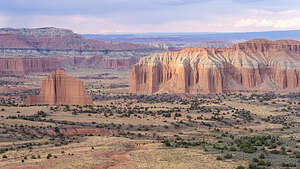 Upper Cathedral Valley OvelookWe continued on to the turnout for Glass Mountain, from which you can photograph all three mountains in a diagonal line.
Upper Cathedral Valley OvelookWe continued on to the turnout for Glass Mountain, from which you can photograph all three mountains in a diagonal line.
The Glass Mountain is a bit of a geological curiosity composed of large selenite (gypsum) crystals forming a mound, or plug, about 15 feet high. I overheard a guide explain to his group that it goes deep underground - I think he said about 60 meters.
I’m no geologist, but I tried to research how it formed. About 165 million years ago, the gypsum was deposited here from evaporating seawater. As it got buried by subsequent layers of sediment, the lower-density gypsum moved slowly upward along fractures in the sediment, forming small domes like Glass Mountain.
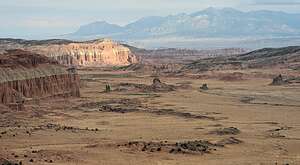 Upper South Desert OverlookSince gypsum is a slightly soluble mineral, precipitation will eventually (over a very long time) dissolve Glass Mountain and create a sinkhole.
Upper South Desert OverlookSince gypsum is a slightly soluble mineral, precipitation will eventually (over a very long time) dissolve Glass Mountain and create a sinkhole.
Pretty awesome. So I climbed to the top of it. It was really easy because the selenite crystals were easy to grab onto. I like to rock climb and I would grade this as a very easy climb. From the top, there was an awesome view of the Temple of the Sun and the Temple of the Moon with the selenite crystals in the foreground.
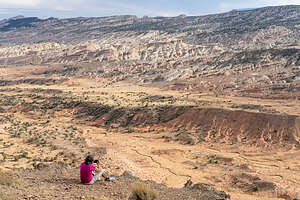 Upper South Desert OverlookWithin the bounds of Cathedral, camping is restricted to the one first-come, first-served primitive campground near Upper Cathedral Valley, which has only 6 campsites, so we needed to get there in time to secure one, so we could enjoy the valley lookouts during the golden hour, both in the evening and at sunrise. The Upper Cathedral Valley is considered one of the most beautiful spots in Utah, and that’s saying a lot.
Upper South Desert OverlookWithin the bounds of Cathedral, camping is restricted to the one first-come, first-served primitive campground near Upper Cathedral Valley, which has only 6 campsites, so we needed to get there in time to secure one, so we could enjoy the valley lookouts during the golden hour, both in the evening and at sunrise. The Upper Cathedral Valley is considered one of the most beautiful spots in Utah, and that’s saying a lot.
When leaving the Temple of the Sun area, we pretty much drove the 15 miles to the campground without stopping much along the way, as tempting as it was.
Success! This time, for whatever reason, there was only one other person camping there, so we secured a site and just relaxed there for a while until the golden hour approached.
.thumbnail.jpg) Sunrise over the Upper Cathedral ValleyAround 4:00, we drove the short distance to the Upper Cathedral Valley Lookout where from the edge of the plateau we could look out over the entire Upper Cathedral Valley in all its splendor.
Sunrise over the Upper Cathedral ValleyAround 4:00, we drove the short distance to the Upper Cathedral Valley Lookout where from the edge of the plateau we could look out over the entire Upper Cathedral Valley in all its splendor.
The monoliths in the Valley looked like the Temple of the Sun and the Temple of the Moon in that they were a reddish-orange sandstone, but these still had their gray-green caps of Curtis Formation sandstone, slowing down their erosion.
There was a very cool outcrop to walk out onto. Looking out at Herb on it, I could see that he was standing on the gray-green cap rock with the softer reddish-orange sandstone below. I was beginning to feel like a geologist.
 Sunrise at the Upper Cathedral Valley LookoutAfterwards we drove the short distance to the Upper South Desert Overlook for even more spectacular views, this time out over the Upper South Desert with its lovely greens and browns.
Sunrise at the Upper Cathedral Valley LookoutAfterwards we drove the short distance to the Upper South Desert Overlook for even more spectacular views, this time out over the Upper South Desert with its lovely greens and browns.
What a beautiful evening!
Back at the campsite, we had Thai food - Mountain House Pad Thai with chicken. It actually wasn’t bad.
The next morning, we arose before sunset and headed back out to the Upper Cathedral Valley Lookout for a spectacular sunrise that painted the surrounding cliffs a brilliant red.
 Sunrise at the Upper Cathedral Valley OverlookI always complain to Herb that we never have photos of the both of us on our trips, so he went to the trouble of setting up a tripod to photograph both of us on an outcrop looking out over the valley. He had to run to get into the picture in time. There are some funny outtakes of the near misses.
Sunrise at the Upper Cathedral Valley OverlookI always complain to Herb that we never have photos of the both of us on our trips, so he went to the trouble of setting up a tripod to photograph both of us on an outcrop looking out over the valley. He had to run to get into the picture in time. There are some funny outtakes of the near misses.
It was pretty stunning.
From there we drove the 30 miles back from whence we came, stopping briefly at the Temple of the Sun and Moon, to Highway 24.
From there we would begin our journey south along the Notom Bullfrog Road to the Burr Trail.
Factory Butte
Wednesday, September 13, 2023 - 10:00pm by Lolo50 miles and 3 hours from our last stop
Travelogue
 Factory Butte in the morningOn our way to Moonscape Overlook yesterday, we had passed right by Factory Butte on our left, not because it is unworthy of a stop, but on the contrary, it is worth an entire day of exploration.
Factory Butte in the morningOn our way to Moonscape Overlook yesterday, we had passed right by Factory Butte on our left, not because it is unworthy of a stop, but on the contrary, it is worth an entire day of exploration.
It is the most recognizable feature in the area, a cathedral-like sandstone hill, set on a wide, flat badlands plateau, surrounded by a sea of Mancos Shale. It is this shale that gives the area its unique appearance of colorful ripples, root-like combs, and crags that you see so often in the foreground of Factory Butte photos.
.thumbnail.jpg) Factory ButteIt is best shot at sunrise, but we were too busy photographing the badlands from the Moonscape Overlook. Too bad you can only be at one place at a time for sunrise. Maybe tomorrow morning, as we planned to camp somewhere near the Butte.
Factory ButteIt is best shot at sunrise, but we were too busy photographing the badlands from the Moonscape Overlook. Too bad you can only be at one place at a time for sunrise. Maybe tomorrow morning, as we planned to camp somewhere near the Butte.
Since we camped at the Moonscape Overlook last night, it was a short drive directly west. It’s very hard to miss as it pretty much dominates the landscape, rising to 6,302 feet above a lunar-like badlands.
 Factory ButteIf you haven’t camped and are coming from Hanksville, just follow the same directions we described for the Moonscape Overlook. Drive 10.6 miles west on Utah 24, and then turn right onto Coal Mine Road (also called Factory Butte Road). From there drive about 5.5 miles on the dirt road for a turnoff.
Factory ButteIf you haven’t camped and are coming from Hanksville, just follow the same directions we described for the Moonscape Overlook. Drive 10.6 miles west on Utah 24, and then turn right onto Coal Mine Road (also called Factory Butte Road). From there drive about 5.5 miles on the dirt road for a turnoff.
We had missed the morning golden hour, but the Butte was still pretty amazing. Today, we would drive around the entire Butte, attacking it from every angle.
.thumbnail.jpg) Lolo trying to find a way across the ravineThe southern end of Factory Butte is actually an OHV area, so there were lots of dune buggy tracks across the plateau, going in every direction. I was just glad there was none zipping about today, as it would have very much destroyed a very peaceful setting.
Lolo trying to find a way across the ravineThe southern end of Factory Butte is actually an OHV area, so there were lots of dune buggy tracks across the plateau, going in every direction. I was just glad there was none zipping about today, as it would have very much destroyed a very peaceful setting.
Up until then, we had been following what was an obviously established dirt road, but then we went off-off-road a bit and followed their tracks.
Continuing on along our circumnavigation of Factory Butte, going north along its eastern side, we turned left onto a dirt road that Gaia showed that would bring us very close to the Butte. We followed it, hoping we would get some interesting foreground, but the road that Gaia indicated led us to a deep ravine, uncrossable by any vehicle.
.thumbnail.jpg) Factory ButteI got out of the car and crossed it on foot, looking for a possible way we could get across. Meanwhile, I saw Herb start driving the car alongside the ravine, looking for me, but I was pretty deep in there. Eventually, I found a shallower spot to climb out of, but had to report that there was no way to get the car across.
Factory ButteI got out of the car and crossed it on foot, looking for a possible way we could get across. Meanwhile, I saw Herb start driving the car alongside the ravine, looking for me, but I was pretty deep in there. Eventually, I found a shallower spot to climb out of, but had to report that there was no way to get the car across.
Oh well. Gaia is usually really good, but conditions do change, so back out to the main road we went.
 Along the drive around Factory ButteWe continued our counter-clockwise drive around the Butte, starting to think about places to camp for the night. This would break our usual camp 2 nights, stay in a hotel 1 night rule, which Herb has implemented to keep me happy, but I was game, especially because the Goblin Valley Campground had a nice shower.
Along the drive around Factory ButteWe continued our counter-clockwise drive around the Butte, starting to think about places to camp for the night. This would break our usual camp 2 nights, stay in a hotel 1 night rule, which Herb has implemented to keep me happy, but I was game, especially because the Goblin Valley Campground had a nice shower.
We rounded the northern end of the Butte and started heading south along its western side, looking for the spot that Herb had marked on Gaia as a possibly good vantage point of Factory Butte’s west side. When we got there, we couldn’t even see the Butte. Then we realized that the steep hill of dirt and shale to our left was blocking us, and the Butte was hiding on the other side.
.thumbnail.jpg) West side of Factory ButteSo, we got out of the car and started scrambling up the hill. As we neared the top, the threatening-looking clouds behind us that had been building towards the west got even more ominous, and we saw our first lightning bolt and shortly (too shortly for my comfort) afterwards the thunder clap.
West side of Factory ButteSo, we got out of the car and started scrambling up the hill. As we neared the top, the threatening-looking clouds behind us that had been building towards the west got even more ominous, and we saw our first lightning bolt and shortly (too shortly for my comfort) afterwards the thunder clap.
Let’s get out of here, Herb said as he started scrambling back down the hill. I was still on my way up, only about 20 yards from the top, so I somewhat foolishing continued up and took a photo. Ironically, the skies over the Butte were blue with nice puffy clouds, but when I turned around to start heading back down to the car, it was a very different situation.
.thumbnail.jpg) Storm's comingI ran as fast as I could down the slippery shale, seeing two more lightning strikes on my way. I was so happy to finally reach the safety of the car before it started to rain pretty hard.
Storm's comingI ran as fast as I could down the slippery shale, seeing two more lightning strikes on my way. I was so happy to finally reach the safety of the car before it started to rain pretty hard.
Although we were safe in the car, our problems weren’t over yet, because it’s not good to be driving in an area prone to flash floods, especially when you have to cross several washes. We looked at Gaia and figured we had about 8 miles to drive to get back to the safety of the asphalt of Highway 24. No time to waste, so we high-tailed it out of there as fast as we could.
 Safe and sound at the Whispering Sands HotelSo much for camping tonight. That’s what happens for trying to break the 2 nights camping, 1 night hotel rule.
Safe and sound at the Whispering Sands HotelSo much for camping tonight. That’s what happens for trying to break the 2 nights camping, 1 night hotel rule.
When we got out to Highway 24, we turned right (west) through Capitol Reef towards Torrey where we thought we would spend the night. Our plans, however, were thwarted when the Fremont River decided to flood the entire road, closing it for hours.
We had no choice but to head back east to Hanksville to hopefully find a place for the night. Luckily, we got the last room at the Whispering Sands Hotel, and who should be there but our good friends Kevin and Mark, sitting in front of their cabin? Didn’t we just see them this morning at the Moonscape sunrise? Obviously, we were traveling in the same circles.
.thumbnail.jpg) Herb and the DukeThis would be the third time we crossed trails. They were going out later that night to do some night sky photography and asked us if we wanted to come along, but we declined, as we had already had a very long day, and we were looking forward to a shower and a nice glass of wine on our fancy porch.
Herb and the DukeThis would be the third time we crossed trails. They were going out later that night to do some night sky photography and asked us if we wanted to come along, but we declined, as we had already had a very long day, and we were looking forward to a shower and a nice glass of wine on our fancy porch.
Plus, we had a night out on the town planned at Duke’s Slickrock Grill. Fortunately, for being the only game in town the food was really good and the portions were very large (Kevin and Mark loved this place), but it was a bit heavy on the meat and light on the vegetable options to support a sustainable healthy lifestyle.
So as they say that Hanksville is a really, really nice place to visit, but I wouldn't want to live here.
Moonscape Overlook
Tuesday, September 12, 2023 - 7:00pm by Lolo20 miles and 0.5 hours from our last stop - 1 night stay
Travelogue
 Excited Herb at the Moonscape OverlookAfter the Mars Desert Research Station and Long Dong Silver, we drove back on Cow Dung Road to Highway 24 and went east about 7 miles or so before turning right onto the bumpy, dirt Coal Mine Road (also called Factory Butte Road) to get to Factory Butte and the Moonscape Overlook (also called Skyline Rim Overlook).
Excited Herb at the Moonscape OverlookAfter the Mars Desert Research Station and Long Dong Silver, we drove back on Cow Dung Road to Highway 24 and went east about 7 miles or so before turning right onto the bumpy, dirt Coal Mine Road (also called Factory Butte Road) to get to Factory Butte and the Moonscape Overlook (also called Skyline Rim Overlook).
There are no signs on these roads indicating where anything is, so we had to rely on Google Maps and Gaia to get where we wanted to go.
After driving about 6 miles on Coal Mine Road, Gaia indicated that we should turn right (east) to get to the Skyline Rim Overlook, ignoring the fact that Factory Butte was on our left. Herb and I were confused, as we thought the overlook was going to overlook Factory Butte.
 Moonscape OverlookWe followed Gaia’s instructions and drove east, but saw nothing but a flat expanse ahead of us. In about 2 miles we came to the end of the road, where we found ourselves perched on the edge of a cliff, looking out over an expanse of badlands, known as the Blue Valley, below us and the Henry Mountains in the distance. It was mind blowing.
Moonscape OverlookWe followed Gaia’s instructions and drove east, but saw nothing but a flat expanse ahead of us. In about 2 miles we came to the end of the road, where we found ourselves perched on the edge of a cliff, looking out over an expanse of badlands, known as the Blue Valley, below us and the Henry Mountains in the distance. It was mind blowing.
There was only one other car there, but no visible passenger anywhere. Not sure where they could have possibly gone as there was no way from here to get down into the badlands.
Looking at Herb’s face, I knew this is where we were going to camp for the night.
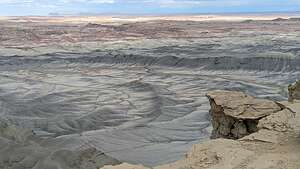 Moonscape OverlookWe set out our chairs to settle in for the evening here, and Herb set his tripod up on one of the outcrops over the badlands. Then we sat and watched the light change and took some photos of this breathtaking scenery. .
Moonscape OverlookWe set out our chairs to settle in for the evening here, and Herb set his tripod up on one of the outcrops over the badlands. Then we sat and watched the light change and took some photos of this breathtaking scenery. .
The light was good, but we knew it was going to be even better in the morning.
We crawled into the back of the 4Runner to get some sleep. The only other vehicle was still empty. Kind of mysterious.
.thumbnail.jpg) Happy Herb camping at MoonscapeThe next morning, before we even got up, we saw several headlights headed our way. By the time we got out of the 4Runner, over a dozen cars were pouring into our little secluded paradise.
Happy Herb camping at MoonscapeThe next morning, before we even got up, we saw several headlights headed our way. By the time we got out of the 4Runner, over a dozen cars were pouring into our little secluded paradise.
Realizing that it was a photo tour group, Herb quickly went out and set up his tripod, claiming the vantage point he wanted for sunrise. We felt we had earned it. Afterall, we slept here all night while all these people were probably in a hotel room.
.thumbnail.jpg) Happy Herb in the morningBut who should we see among the newly-arrived crowd then our friends Kevin and Mark, the two night-sky photographers that we had met at the Goblin Valley Observation Point just last night.
Happy Herb in the morningBut who should we see among the newly-arrived crowd then our friends Kevin and Mark, the two night-sky photographers that we had met at the Goblin Valley Observation Point just last night.
It felt like we were meeting old friends as we shared what we each had done that day and what we had photographed.
Then we got down to business, watching the sun light up the badlands in all their splendor. And we didn’t even have coffee yet!
.thumbnail.jpg) Moonscape in the morningThere were photographers scattered on every outcrop. Some idiots were even climbing up on a precarious narrow spire to take selfies of themselves. You couldn’t pay me enough to risk that for a photo. What a difference from last night when we had the whole place to ourselves.
Moonscape in the morningThere were photographers scattered on every outcrop. Some idiots were even climbing up on a precarious narrow spire to take selfies of themselves. You couldn’t pay me enough to risk that for a photo. What a difference from last night when we had the whole place to ourselves.
Once the sun was up, people started getting back in their cars and driving back towards Factory Butte. Just as quickly as they came, they were gone, and we once again had this lovely place to ourselves.
After a quick breakfast, we got back in the 4Runner and started driving west back towards Factory Butte, with the intention of driving around the entire thing, seeing it from all vantage points.
Long Dong Silver (the Lone Spire)
Tuesday, September 12, 2023 - 3:30pm by Lolo20 miles and 0.5 hours from our last stop
Travelogue
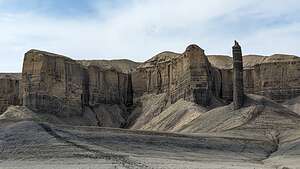 Angel of DeathHerb loves watching YouTube videos of places we are going to, and he often goes down a rabbit hole and finds new points of interest. This is how while watching videos about Factory Butte, he found out about the nearby Lone Spire (cleverly named “Long Dong Silver” by rock climbers).
Angel of DeathHerb loves watching YouTube videos of places we are going to, and he often goes down a rabbit hole and finds new points of interest. This is how while watching videos about Factory Butte, he found out about the nearby Lone Spire (cleverly named “Long Dong Silver” by rock climbers).
With a name like that, we definitely had to see it. To drive to it requires a high-clearance 4WD, which fortunately is our means of travel these days for this very reason.
I’ll try to give directions, but it is much easier to simply put “Lone Spire” into Google Maps and it will navigate you there. Also, we use Gaia, which has a lot more details on remote 4wd trails.
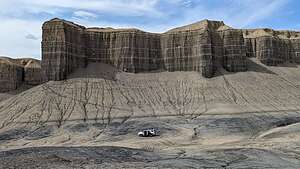 Parking for the hike up to Long Dong SilverIn case you have no coverage, from Hanksville, drive west on Highway 24 for 10.6 miles and turn right onto Coal Mine Road (also called Factory Butte Road). From there we drove about 4 miles north and then turned right onto Factory Bench Road. After another 2 miles, we made another right.
Parking for the hike up to Long Dong SilverIn case you have no coverage, from Hanksville, drive west on Highway 24 for 10.6 miles and turn right onto Coal Mine Road (also called Factory Butte Road). From there we drove about 4 miles north and then turned right onto Factory Bench Road. After another 2 miles, we made another right.
If you don’t have a 4WD, you can hike directly there from Highway 24. We didn’t do this, but I think you can drive about 7.5 miles west on 24 from Hanksville and park on the side of the road. From there, I believe it is a 1.8-mile hike north up a wash to the spire.
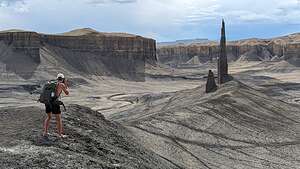 Long (and Short) Dong SilverAlong our drive, we stopped at another spire that Herb had learned about on YouTube, called Angel of Death, also named by rock climbers who are known to give very colorful names to rocks they climb.
Long (and Short) Dong SilverAlong our drive, we stopped at another spire that Herb had learned about on YouTube, called Angel of Death, also named by rock climbers who are known to give very colorful names to rocks they climb.
The Angel of Death rose 80 feet from a dirt mound. Behind it was a huge mass of rock colored in the same deep browns with lighter tan horizontal lines across it. I wish I knew geology better, but I do know that these lines are strata, and they tell the story of the rock. Each distinct layer shows a change in the landscape going back millions of years.
It definitely looked like the Angel of Death was once part of the massive block of rock behind it, but erosion must have separated it some time along the way, possibly millions of years ago.
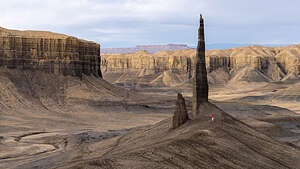 Little Lolo on Long DongWe continued onto Long Dong Silver and parked the 4Runner at the base of another massive brown with tan striped rock formation, similar to the one by Angel of Death.
Little Lolo on Long DongWe continued onto Long Dong Silver and parked the 4Runner at the base of another massive brown with tan striped rock formation, similar to the one by Angel of Death.
Like Angel of Death, Long Dong Silver was located atop a dirt mound and had the same brown and tan strata lines.
From the car, we walked up the hill, but rather than walk towards the spire, we went left and climbed up a very steep section of trail to another large block of the same kind of rock. From this vantage point, we could see that there were actually two spires, the 100-foot-high Long Dong, and its shorter side-kick (Short Dong Silver?), about a third the size.
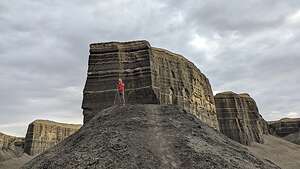 Herb's photo vantage pointIn landscape photography, it is difficult to get a sense of scale of an object if there is nothing in the photo that you do know the size of. That’s where I come in. I appear in hundreds of Herb’s photos as a tiny little object, displaying my insignificance in nature. I don’t mind though - not the insignificant part but the exercise.
Herb's photo vantage pointIn landscape photography, it is difficult to get a sense of scale of an object if there is nothing in the photo that you do know the size of. That’s where I come in. I appear in hundreds of Herb’s photos as a tiny little object, displaying my insignificance in nature. I don’t mind though - not the insignificant part but the exercise.
So, for the next hour I got a good workout, walking back and forth between the spire and the steep mound where Herb had set up a tripod. I am such a good wife.
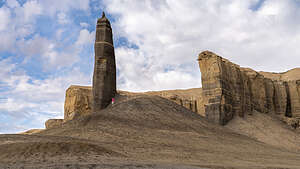 Lolo and the Angel of DeathAfter looking at the photos later that evening, Herb saw some missed opportunities, so we actually went back again two days later on our way to Cathedral Valley
Lolo and the Angel of DeathAfter looking at the photos later that evening, Herb saw some missed opportunities, so we actually went back again two days later on our way to Cathedral Valley
On that return trip out here, I also got out of the car at Angel of Death and climbed up to its base, which wasn’t as easy as I thought it would be.
Herb calls me his supermodel - his very tiny supermodel.
Mars Desert Research Station
Tuesday, September 12, 2023 - 2:15pm by Lolo20 miles and 0.5 hours from our last stop
Travelogue
.thumbnail.jpg) Bentonite Hills on the way to the MDRSWe left Hanksville and drove west on Utah 24 for about 3.5 miles before turning right onto Cow Dung Road. From there we drove about 7 miles through the incredible red and white bentonite hills before coming to the Mars Desert Research Station.
Bentonite Hills on the way to the MDRSWe left Hanksville and drove west on Utah 24 for about 3.5 miles before turning right onto Cow Dung Road. From there we drove about 7 miles through the incredible red and white bentonite hills before coming to the Mars Desert Research Station.
These colorful hills are formed of mud, silt, sand and volcanic ash deposited in swamps and lakes in the Jurassic Period. Their surface is like popcorn and becomes an impassible, sticky mess when rained on, so we had to be sure we kept our eyes on the weather.
It felt like we were on Mars. In fact, it was chosen for field research because of its similarities to the red planet. So much so that it was used as the setting of the fictional planet Vulcan in the 2009 film Star Trek.
.thumbnail.jpg) Mars Desert Research StationBuilt and managed by the Mars Society, it is one of only four simulated Mars habitats in the world being used to simulate the hardships and challenges that pioneers would face in a potential colonization of Mars.
Mars Desert Research StationBuilt and managed by the Mars Society, it is one of only four simulated Mars habitats in the world being used to simulate the hardships and challenges that pioneers would face in a potential colonization of Mars.
Although not allowed on the grounds, we could see several of the buildings. The two-story, eight-meter cylindrical one is called the “Habitat,” also known as “Hab.”
Astronauts and research crews spend two weeks at a time living in Hab. To most realistically simulate the Martian environment, they wear space suits and carry walkie talkies whenever they step outside Hab.
.thumbnail.jpg) Painted Hills beyond the MDRSIt would have been so cool to see astronauts wandering around the bentonite hills, but I later learned that they are only here from October to May - I guess because of the heat.
Painted Hills beyond the MDRSIt would have been so cool to see astronauts wandering around the bentonite hills, but I later learned that they are only here from October to May - I guess because of the heat.
From the MDRS, we continued driving north on Cow Dung Road for 4 miles to an area called the Painted Hills, marked on Google with a photo icon meaning it’s photogenic. It certainly was.
I don’t know how to describe it other than to say there were white rock pedestals topped with a slanted golden rock boulder. I wish I knew how they were formed and what kind of rock they were, but I don’t. They were beautiful to look at though.
Goblin Valley State Park
Monday, September 11, 2023 - 5:15pm by Lolo10 miles and 0.25 hours from our last stop - 1 night stay
Travelogue
.thumbnail.jpg) Goblin Valley CampgroundAfter our slot canyon hike, we headed over to the Goblin Valley Campground to “check in.” When we booked this campsite, the only one available was a “tent” site, so if we were traveling here in our Lazy Daze, we would have been out of luck. Our walk-in site included a picnic table with a shade covering, a grill, and a pad to put our non-existent tent on. All we needed was our parking spot.
Goblin Valley CampgroundAfter our slot canyon hike, we headed over to the Goblin Valley Campground to “check in.” When we booked this campsite, the only one available was a “tent” site, so if we were traveling here in our Lazy Daze, we would have been out of luck. Our walk-in site included a picnic table with a shade covering, a grill, and a pad to put our non-existent tent on. All we needed was our parking spot.
.thumbnail.jpg) Looking out over the Valley of GoblinsThe campground was very nice - set in a lovely setting surrounded by red rock walls with clean, modern bathrooms that even had showers.
Looking out over the Valley of GoblinsThe campground was very nice - set in a lovely setting surrounded by red rock walls with clean, modern bathrooms that even had showers.
Campsites were $45 per night, which was a bargain for what you got.
After a late lunch and a brief nap in the back of the truck, we headed over to Observation Point where we could look out over the Valley of the Goblins below. It’s the best view in the Park.
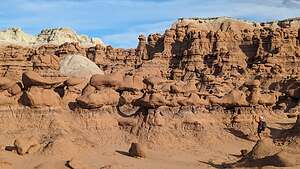 Herb and the Green Dome fantasylandThe valley, which is about a mile across and two miles long, is full of thousands of strange rock formations that resemble goblins. I kind of thought they looked more like mushrooms or giant phalluses, but I can see why the state of Utah went with the name Goblin Valley instead of the alternatives.
Herb and the Green Dome fantasylandThe valley, which is about a mile across and two miles long, is full of thousands of strange rock formations that resemble goblins. I kind of thought they looked more like mushrooms or giant phalluses, but I can see why the state of Utah went with the name Goblin Valley instead of the alternatives.
These pinnacles, which are only a few meters high, are composed of large, reddish-brown boulders which sit atop weaker sandy layers that have eroded away more quickly. The formations are nearly as dramatic as those in the more popular National Parks, but on a smaller scale and without the crowds.
.thumbnail.jpg) Lolo wandering through the Valley of GoblinsIt was still a bit hot, and the light on the goblins was still a bit harsh, so we passed the time waiting for the golden hour sipping a glass of wine at one of the picnic tables in the Observation Shelter. It’s times like this that I really appreciate the refrigerator we have in the back of the 4Runner.
Lolo wandering through the Valley of GoblinsIt was still a bit hot, and the light on the goblins was still a bit harsh, so we passed the time waiting for the golden hour sipping a glass of wine at one of the picnic tables in the Observation Shelter. It’s times like this that I really appreciate the refrigerator we have in the back of the 4Runner.
Once the light began to change and our glasses were empty, we took the short path from the Observation Shelter down into the Valley and wandered aimlessly amongst the goblins. There really was no specific trail to follow, so we just kind of randomly headed towards any formation that captured our fancy.
.thumbnail.jpg) Bright red castlesThe “goblins” were very cute and being able to walk amongst them and get up close and personal gave a quite enjoyable and intimate feel to the place.
Bright red castlesThe “goblins” were very cute and being able to walk amongst them and get up close and personal gave a quite enjoyable and intimate feel to the place.
We headed across the Valley to a large copper green dome where we climbed up a hill and down into a fantasyland of spires and chimneys.
.thumbnail.jpg) Balancing rocksAfter that Herb and I went in different directions. He likes to stay in one place and photograph the intimate details of a subject, while I like to run around like a nut, ensuring myself that I’m not missing anything, and taking in the overall scene.
Balancing rocksAfter that Herb and I went in different directions. He likes to stay in one place and photograph the intimate details of a subject, while I like to run around like a nut, ensuring myself that I’m not missing anything, and taking in the overall scene.
I don’t have a particularly good sense of direction, and it was a bit confusing wandering aimlessly through the maze of hoodoos, many of which looked alike, so I tried to keep the Observation Shelter up top always in my sight.
.thumbnail.jpg) Morning meeting with the aliensEventually I found Herb and we walked together back up to the Observation Shelter.
Morning meeting with the aliensEventually I found Herb and we walked together back up to the Observation Shelter.
Before heading back to the campground, we got to talking to two gentlemen, Kevin from Arkansas and Mark from Manhattan. They told us that they met 26 years ago on a photo tour to Alaska and decided that they could do their own photo tours together as well. They have been doing that now for 25 years. Their specialty and passion is night sky photography and they showed us some spectacular photos they have taken of the Milky Way over iconic landscapes.
.thumbnail.jpg) Take me to your leaderThe next morning we arose in time to get back to Observation Point for sunrise.
Take me to your leaderThe next morning we arose in time to get back to Observation Point for sunrise.
Once again, we hiked down into the Valley of Goblins. This time I headed towards the left rather than the right and wound up in a wonderland of ET-like figures. You could definitely let your imagination run wild in this place - aliens, castles, mushrooms, phalluses, and more. It was like playing the cloud shape game.
After climbing back up to Observation Point, we drove out the park exit and turned right onto a dirt spur road to Molly’s Castle, a gigantic red butte that looks a bit like a Medieval castle, rising 265 feet above the surrounding terrain.
.
.thumbnail.jpg) Molly's CastleFrom here we could have continued on the very bumpy dirt road for about 10 miles for a short cut back to Highway 24, but unsure of the road conditions, we went back to the Goblin Valley State Park exit and took the longer asphalt workaround.
Molly's CastleFrom here we could have continued on the very bumpy dirt road for about 10 miles for a short cut back to Highway 24, but unsure of the road conditions, we went back to the Goblin Valley State Park exit and took the longer asphalt workaround.
From there we headed to the town of Hanksville, stopping for lunch at Duke’s Slickrock Grill before heading out to explore more of the southern section of the San Rafael Swell, northwest of town.
Little Wild Horse Slot Canyon
Monday, September 11, 2023 - 10:15am by Lolo20 miles and 0.5 hours from our last stop
Travelogue
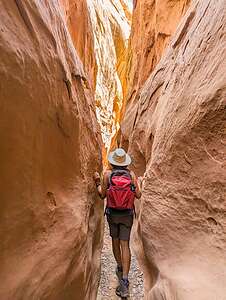 Little Wild Horse Slot CanyonWhen we arrived at the Goblin Valley Visitor Center we looked at the weather forecast and saw the possibility of thunderstorms tomorrow, but no threat of rain today. Hmmm…That might change our plans a bit.
Little Wild Horse Slot CanyonWhen we arrived at the Goblin Valley Visitor Center we looked at the weather forecast and saw the possibility of thunderstorms tomorrow, but no threat of rain today. Hmmm…That might change our plans a bit.
Knowing that a slot canyon was not a good place to be in a thunderstorm, we immediately switched our plans from hiking Little Wild Horse Slot Canyon from tomorrow to today - in fact, pretty much to right now.
We really didn’t want to miss out on this hike, as it is the most popular in the entire San Rafael Swell, and that’s saying a lot.
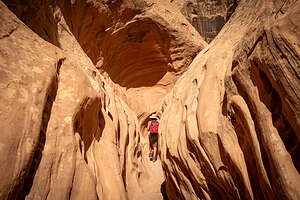 Little Wild Horse Slot CanyonNormally, I wouldn’t want to start a desert hike at high noon, but a little light in a slot canyon isn’t necessarily a bad thing. Plus, we would probably find lots of shade as well.
Little Wild Horse Slot CanyonNormally, I wouldn’t want to start a desert hike at high noon, but a little light in a slot canyon isn’t necessarily a bad thing. Plus, we would probably find lots of shade as well.
Little Wild Horse Canyon is not officially part of Goblin Valley State Park, but the dirt road to the trailhead is right by the Park entrance. So, rather than even enter Goblin Valley now, we drove the 5 miles down the Little Wild Horse Canyon dirt road to the trailhead. There were several cars in the parking lot, but most people were exiting the canyon, as they had started their hike in the morning, as we normally would.
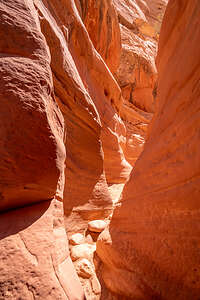 Little Wild Horse Slot CanyonAfter parking our car, we took the trail leading to the dry wash bed and followed it for a few hundred yards. After about 10 minutes, the riverbed narrowed and we came to a dry waterfall, which we got around by ascending an inclined plane to the left of it.
Little Wild Horse Slot CanyonAfter parking our car, we took the trail leading to the dry wash bed and followed it for a few hundred yards. After about 10 minutes, the riverbed narrowed and we came to a dry waterfall, which we got around by ascending an inclined plane to the left of it.
Continuing along the wash, I almost missed the right turn at the fork into Little Wild Horse Canyon. In fact, I didn’t even see the fork, until Herb called me back. It’s easy to miss because the entrance is a concealed slit at the right side of the canyon. There is a sign though.
The other way went to Bell Canyon. You can do an 8-mile loop around both Little Wild Horse and Bell Canyons, but that wasn’t our plan for today. We still had lots to do in Goblin Valley.
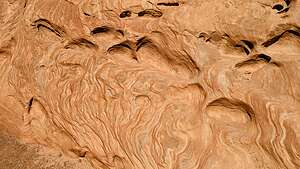 Textured walls of Little Wild Horse Slot CanyonA few hundred yards further, things got really interesting, both in terms of color and texture of the rock walls. The soft light reflecting off the canyon walls painted the rocks a vibrant red, and interesting holes, niches, and swirls were carved out by millions of years of water action on the walls. It was stunning.
Textured walls of Little Wild Horse Slot CanyonA few hundred yards further, things got really interesting, both in terms of color and texture of the rock walls. The soft light reflecting off the canyon walls painted the rocks a vibrant red, and interesting holes, niches, and swirls were carved out by millions of years of water action on the walls. It was stunning.
After about a mile and a half, we came to a very narrow and wet section, which would have required us getting our boots wet, so we turned around and went back from whence we came.
The hike was a little over 3-miles with very little elevation gain.
San Rafael Swell
Monday, September 11, 2023 - 9:30am by Lolo200 miles and 4 hours from our last stop
Travelogue
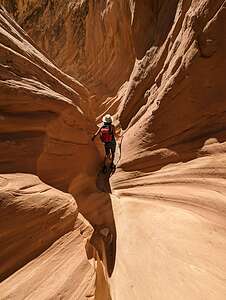 Little Wild Horse Slot CanyonWhen Herb dreamed up this spur of the moment Utah trip, all he could talk about was wanting to see Factory Butte. In fact, before I got involved, that was his entire itinerary.
Little Wild Horse Slot CanyonWhen Herb dreamed up this spur of the moment Utah trip, all he could talk about was wanting to see Factory Butte. In fact, before I got involved, that was his entire itinerary.
However, there’s a lot more cool stuff to see in the San Rafael Swell area besides Factory Butte, like the Little Wild Horse Canyon, Goblin Valley, the Mars Desert Research Station, Long Dong Silver, and the Moonscape Overlook. I will provide more detail on each of these in the following stops.
The San Rafael Swell is an oval-shaped uplifted area of layered rocks (anticlines) in south-central Utah that covers about 75 by 40 miles.
.thumbnail.jpg) Bentonite HillsIt is characterized by mesas, cliffs, buttes, magnificent badlands of brightly colored and wildly eroded sandstone formations, and canyons.
Bentonite HillsIt is characterized by mesas, cliffs, buttes, magnificent badlands of brightly colored and wildly eroded sandstone formations, and canyons.
I-70 cuts right through it and divides the swell into northern and southern sections, and provides the only interstate access to the region. The only town of any significant size in The Swell is Green River, located on I70. We would be exploring the southern section.
With the exception of that, it is one of the emptiest and least developed regions in Utah and one of the last great wilderness areas of the Southwest without National Park or Monument status.
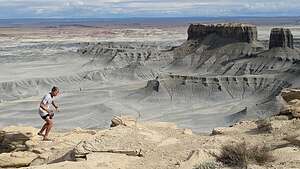 Moonscape OverlookSo for now at least, few people are aware of its stunning beauty and recreational opportunities. That plus its confusing network of dirt roads will hopefully keep it undiscovered for a while longer.
Moonscape OverlookSo for now at least, few people are aware of its stunning beauty and recreational opportunities. That plus its confusing network of dirt roads will hopefully keep it undiscovered for a while longer.
It is mostly owned by the BLM, which Herb loves, because that means it is open to all and access is unrestricted, meaning we could pretty much camp anywhere.
The nearest town with any services is Hanksville (population 162) at the junction of Utah 24 and Utah 95. Its location is very convenient to a lot of cool places and serves as a great base camp for exploring this section of the southern section of the San Rafael Swell.
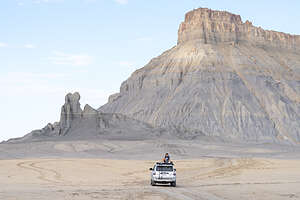 Factory ButteThere are 3 hotels in the town and 3 restaurants, the most popular being Duke’s Slickrock Grill. We actually had eaten here the last time we passed through here.
Factory ButteThere are 3 hotels in the town and 3 restaurants, the most popular being Duke’s Slickrock Grill. We actually had eaten here the last time we passed through here.
It is named after John Wayne, and the place is full of memorabilia about the Duke. Herb even posed with a Duke cutout at the bar.
The restaurant is really good and serves very large portions - a bit too slanted to meat over vegetables though for my taste. Still, it was pretty much the only game in town, so we ate there for lunch before heading out to explore the San Rafael Swell area northwest of Hanksville.
Delta
Sunday, September 10, 2023 - 8:15pm by Lolo96 miles and 1.5 hours from our last stop - 1 night stay
Travelogue
 Herb sad that he missed Burning ManWe didn’t want to drive too much further today, as it was already after 2:00 pm, so we set our sights on the little town of Delta about an hour and a half more on US 50 into Utah. Although US 50 in Utah is no longer referred to as the “Loneliest Road,” it was still pretty lonely. There was nothing in between Great Basin and Delta.
Herb sad that he missed Burning ManWe didn’t want to drive too much further today, as it was already after 2:00 pm, so we set our sights on the little town of Delta about an hour and a half more on US 50 into Utah. Although US 50 in Utah is no longer referred to as the “Loneliest Road,” it was still pretty lonely. There was nothing in between Great Basin and Delta.
Actually, I take that back. Herb managed to find an empty playa (dried up Sevier Lake) and got off US 50 to take a dirt road down to it. He was tempted to drive out onto it, but it was a little muddy mushy from the recent rains, and I didn’t want to do what happened to vehicles a few weeks back at Burning Man.
 Sevier PlayaInstead, he satisfied himself with walking out onto it. I kidded that this might be a way for him to work out his grief over missing Burning Man. He was not amused.
Sevier PlayaInstead, he satisfied himself with walking out onto it. I kidded that this might be a way for him to work out his grief over missing Burning Man. He was not amused.
I enjoy a good playa as well, so I joined him.
As we entered the town of Delta, Utah, we began looking for a place to stay. I yelled to Herb to turn the car around and drive back a short distance. I told him I found the perfect place. He was also not amused when I pointed at the Delta Schitt’s Creek motel. Hahahaha
 HahahahaStaying there would have been worth it, just to tell the kids.
HahahahaStaying there would have been worth it, just to tell the kids.
Instead, we stayed at a Days Inn Wyndham, which was pretty nice. Plus, it was a short walk from our hotel to Taco Shop El Jalisciense, where I had a really good quesadilla.
From Delta, it was just a little over 3 hours to Goblin Valley. Perfect!
Great Basin National Park
Sunday, September 10, 2023 - 11:15am by Lolo156 miles and 3 hours from our last stop
Travelogue
 Reverse tree huggerAfter spending a short time photographing the Eureka Main Street, we continued east on “The Loneliest Road,” eventually passing through the town of Ely, Nevada (mile 320). With a population of 4,002, it was significantly larger than Eureka.
Reverse tree huggerAfter spending a short time photographing the Eureka Main Street, we continued east on “The Loneliest Road,” eventually passing through the town of Ely, Nevada (mile 320). With a population of 4,002, it was significantly larger than Eureka.
 Bristlecone PineEly is the site of Nevada’s largest and longest-lived mining ventures, but they mined for copper, not silver or gold. At its peak during the 1950s, Ely produced over a billion dollars worth of copper ore and employed over 10,000 people. After the mines closed down in 1982, the town went bust and the railroad depot was turned into the Nevada Northern Railway Museum. However, it is still one of the larger towns on the Loneliest Road and home to the only supermarket in 250 miles.
Bristlecone PineEly is the site of Nevada’s largest and longest-lived mining ventures, but they mined for copper, not silver or gold. At its peak during the 1950s, Ely produced over a billion dollars worth of copper ore and employed over 10,000 people. After the mines closed down in 1982, the town went bust and the railroad depot was turned into the Nevada Northern Railway Museum. However, it is still one of the larger towns on the Loneliest Road and home to the only supermarket in 250 miles.
East of Ely, US-50 continues another 25 miles before ascending 7,722-foot Connors Pass. From the summit, 13,061-foot Wheeler Peak comes into view.
In another 20 miles is the town of Baker and the turnoff for Great Basin National Park, Nevada’s only national park. It’s also one of the smallest parks in the national park system, and its remote location near the Nevada-Utah border also makes it one of the least visited.
 Wheeler Peak comes into viewWe were now 382 miles from Reno, almost done with the 400 miles through Nevada on the Loneliest Road.
Wheeler Peak comes into viewWe were now 382 miles from Reno, almost done with the 400 miles through Nevada on the Loneliest Road.
Despite Great Basin’s small size, it boasts a treasure trove of riches, including:
- the only glacier in Nevada
- 13,063-foot Wheeler Peak, the second highest mountain in the state
- a large forest of 3,000- to 4,000-year-old bristle-cone pines, the oldest living creatures on the planet
- groves of white-barked aspen
- the extensive and fascinating Lehman Caves.
The last time we were here back in 2007, we only visited the Lehman Caves, because we were not allowed to drive up to Wheeler Peak in our Lazy Daze motorhome, (no vehicles over 20 feet allowed). The Wheeler Peak Road is about 12 miles one way and climbs 3,400 feet in elevation as it winds its way up the Snake Mountain Range. Not appropriate for a motorhome.
.thumbnail.jpg) Rock GlacierIt was, however, very appropriate for our Toyota 4Runner, so up we went to Wheeler Peak, where we would start our Bristlecone and Glacier hike. Pretty cool that in one hike we would be able to walk amongst the oldest living species on Earth, and see Nevada’s only remaining glacier (before it melts away).
Rock GlacierIt was, however, very appropriate for our Toyota 4Runner, so up we went to Wheeler Peak, where we would start our Bristlecone and Glacier hike. Pretty cool that in one hike we would be able to walk amongst the oldest living species on Earth, and see Nevada’s only remaining glacier (before it melts away).
We headed out on the Bristlecone Glacier trail and in about a mile came to a grove of Bristlecone Pines, which are the world’s oldest living species, the longest having lived almost 5,000 years.
They are very photogenic, each of them individually sculpted by thousands of years of wind, ice, and extreme exposure to the elements. Their twisted and contorted shapes are evidence of their ability to not only survive, but to thrive in adverse living conditions. It’s funny how the harshest growing conditions produce trees that live the longest and are the most contorted and interesting. There’s much to be said for tough love.
.thumbnail.jpg) Out on the iceOne thing I did not though was that the bristlecones here looked much less healthy than the ones we had recently visited in the Ancient Bristlecone Pine Forest in Big Pine, California. Many of the ones in Great Basin were dead - you can tell by the fact that they are gray rather than having that rich brownish chocolate coloring. Not sure why that might be. Maybe it has something to do with climate change and the differing attitudes and environments of the different groves.
Out on the iceOne thing I did not though was that the bristlecones here looked much less healthy than the ones we had recently visited in the Ancient Bristlecone Pine Forest in Big Pine, California. Many of the ones in Great Basin were dead - you can tell by the fact that they are gray rather than having that rich brownish chocolate coloring. Not sure why that might be. Maybe it has something to do with climate change and the differing attitudes and environments of the different groves.
Once past the Bristlecone Pine Grove, the woods became more sparse and we got our first clear views of Wheeler Peak Glacier, which sits at the base of Wheeler Peak, in a protected cirque around 11,500 feet in elevation.
As we proceeded up onto the glacier moraine, the trail became much rockier and unstable, as we transitioned into alpine territory.
.thumbnail.jpg) Out on the iceUnlike the ice glaciers we had seen on our recent trip to Iceland, the Wheeler Peak Glacier is a rock glacier, meaning that the ice visible on the surface is only a portion of the whole glacier, the rest is covered with debris and therefore considered to be a rock glacier.
Out on the iceUnlike the ice glaciers we had seen on our recent trip to Iceland, the Wheeler Peak Glacier is a rock glacier, meaning that the ice visible on the surface is only a portion of the whole glacier, the rest is covered with debris and therefore considered to be a rock glacier.
The glacier itself isn’t all that impressive, as it is shrinking due to climate change, but the surrounding cirque and towering peaks were beautiful.
When we got to the foot of the glacier, of course, we couldn’t resist walking out on it.
With the exception of the altitude (over 10,200 feet ), it was not a difficult hike - just 4.5 miles with a little over 1,000 foot elevation gain
